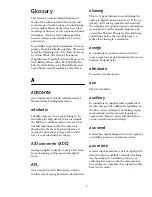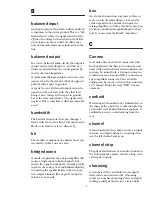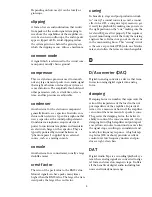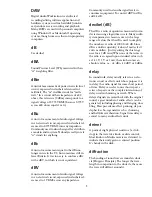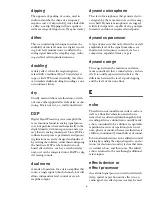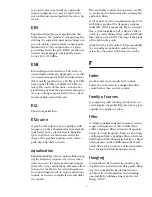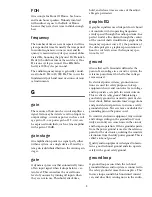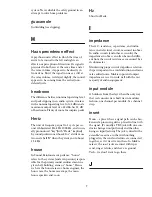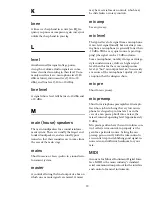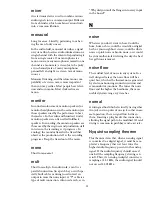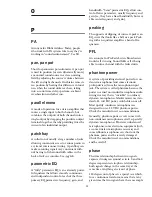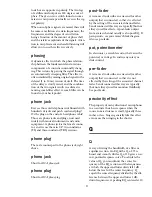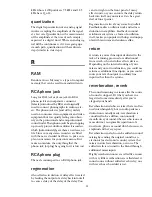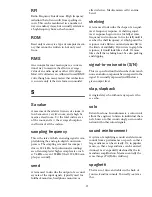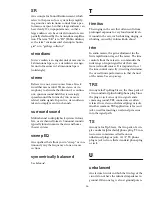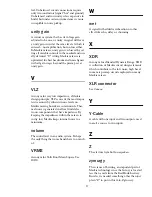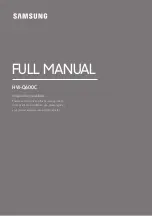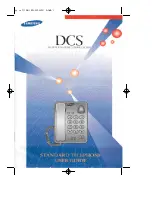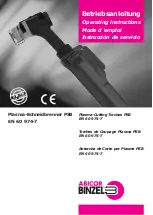
7
as an insert processor (serial) on a particular
input or subgroup, or it may be used via the
aux send/return system (parallel). See also echo,
reverb.
EIN
Equivalent Input Noise. A specification that
helps measure the “quietness” of a gain stage by
deriving the equivalent input noise voltage nec-
essary to obtain a given preamp’s output noise.
Numerically, it’s the output noise at a given
gain setting minus the gain. EIN is usually mea-
sured at maximum gain and typically ranges
from -125 to -130 dBm.
EMI
Electro-Magnetic Interference. This refers to
current induced into the signal path as a result
of an external magnetic field. In audio systems,
this is usually manifested as a 60 Hz or 120 Hz
hum or buzz (50 Hz or 100 Hz in 50 Hz sys-
tems). The source of this noise can be from a
ground loop or from the signal wire coming too
close to a strong magnetic field such as a trans-
former or high-current linecord.
EQ
Short for equalization.
EQ curve
A graph of the response of an equalizer, with
frequency on the x (horizontal) axis and ampli-
tude (level) on the y (vertical) axis. Equalizer
types and effects are often named after the
shape of the graphed response curve, such as
peak, dip, bell, shelf, or notch.
equalization
Equalization (EQ) refers to purposefully chang-
ing the frequency response of a circuit, some-
times to correct for previous unequal response
(hence the term, equalization), and more often
to boost or cut the level at certain frequencies
for sound enhancement, to remove extraneous
sounds, or to create completely new and differ-
ent sounds.
Bass and treble controls on your stereo are EQ;
so are the units called parametrics and graphics
and notch filters.
A lot of how we refer to equalization has to do
with what a graph of the frequency response
looks like. A flat response (no EQ) is a straight
line; a peak looks like a hill, a dip is a valley, a
notch is a really skinny valley, and a shelf looks
like a plateau (or a shelf). The slope is the grade
of the hill on the graph.
Aside from the level controls, EQs are probably
the second most powerful controls on any
mixer (no, the power switch doesn’t count!).
F
fader
Another name for an audio level control.
Today, the term refers to a straight-line slide
control rather than a rotary control.
family of curves
A composite graph showing on one chart sev-
eral examples of possible EQ curves for a given
equalizer or equalizer section.
filter
A simple equalizer designed to remove certain
ranges of frequencies. A low-cut filter (also
called a high-pass filter) attenuates frequencies
below its cutoff frequency. There are also high-
cut (low-pass) filters, bandpass filters, which cut
both high and low frequencies but leave a band
of frequencies in the middle untouched, and
notch filters, which remove a narrow band but
leave the high and low frequencies alone.
flanging
A term for an effect similar in sound to phas-
ing. Before we had electronic delay units, flang-
ing was accomplished by playing two tape
machines in synchronization, then delaying
one slightly by rubbing a finger on the reel
flange. Get it?


